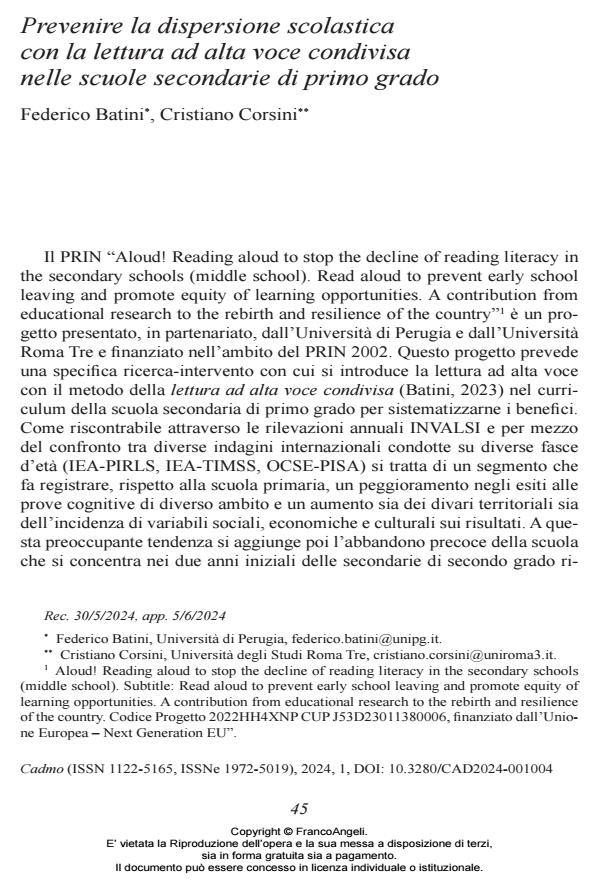Preventing school dropout with shared reading aloud in middle schools
Journal title CADMO
Author/s Federico Batini, Cristiano Corsini
Publishing Year 2024 Issue 2024/1
Language Italian Pages 16 P. 45-60 File size 221 KB
DOI 10.3280/CAD2024-001004
DOI is like a bar code for intellectual property: to have more infomation
click here
Below, you can see the article first page
If you want to buy this article in PDF format, you can do it, following the instructions to buy download credits

FrancoAngeli is member of Publishers International Linking Association, Inc (PILA), a not-for-profit association which run the CrossRef service enabling links to and from online scholarly content.
This study investigates the impact of shared reading aloud on preventing school dropout in middle schools, specifically targeting students aged 11 to 14. The research is part of the Prin “Aloud! Reading aloud to stop the decline of reading literacy in the secondary schools (middle school). Read aloud to prevent early school leaving and promote equity of learning opportunities. A contribution from educational research to the rebirth and resilience of the country”, a collaboration between the University of Perugia and Roma Tre University. The project aims to integrate shared reading aloud into the middle school curriculum to enhance literacy and cognitive skills, thereby reducing early school leaving and promoting educational equity. The research employs a quasi-experimental design involving 36 classes (approximately 900 students) randomly assigned to either an intervention or a control group. In the intervention group, 80 hours of curriculum time are dedicated to reading aloud narrative fiction, while the control group continues with regular academic activities. Teachers in the intervention group receive intensive training on shared reading aloud method. The project’s broader goal is to demonstrate that systematic and intensive reading aloud can enhance educational outcomes and prevent school dropout, particularly in socioeconomically disadvantaged areas. The preliminary findings support the integration of shared reading aloud into educational practices to foster a more equitable learning environment and promote long-term academic success.
Keywords: shared reading aloud, preventing dropout in middle school, reinforcing literacy for school success, effects and benefits of shared read aloud stories from 11 to 14 years old, empowerment through shared reading aloud.
Federico Batini, Cristiano Corsini, Prevenire la dispersione scolastica con la lettura ad alta voce condivisa nelle scuole secondarie di primo grado in "CADMO" 1/2024, pp 45-60, DOI: 10.3280/CAD2024-001004